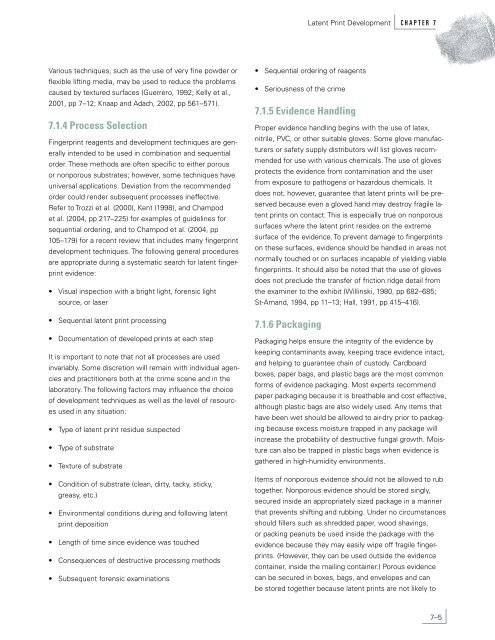Latent Print Development - National Criminal Justice Reference ...
Latent Print Development - National Criminal Justice Reference ...
Latent Print Development - National Criminal Justice Reference ...
Create successful ePaper yourself
Turn your PDF publications into a flip-book with our unique Google optimized e-Paper software.
Various techniques, such as the use of very fine powder or<br />
flexible lifting media, may be used to reduce the problems<br />
caused by textured surfaces (Guerrero, 1992; Kelly et al.,<br />
2001, pp 7–12; Knaap and Adach, 2002, pp 561–571).<br />
7.1.4 Process Selection<br />
Fingerprint reagents and development techniques are gen-<br />
erally intended to be used in combination and sequential<br />
order. These methods are often specific to either porous<br />
or nonporous substrates; however, some techniques have<br />
universal applications. Deviation from the recommended<br />
order could render subsequent processes ineffective.<br />
Refer to Trozzi et al. (2000), Kent (1998), and Champod<br />
et al. (2004, pp 217–225) for examples of guidelines for<br />
sequential ordering, and to Champod et al. (2004, pp<br />
105–179) for a recent review that includes many fingerprint<br />
development techniques. The following general procedures<br />
are appropriate during a systematic search for latent finger-<br />
print evidence:<br />
• Visual inspection with a bright light, forensic light<br />
source, or laser<br />
• Sequential latent print processing<br />
• Documentation of developed prints at each step<br />
It is important to note that not all processes are used<br />
invariably. Some discretion will remain with individual agen-<br />
cies and practitioners both at the crime scene and in the<br />
laboratory. The following factors may influence the choice<br />
of development techniques as well as the level of resourc-<br />
es used in any situation:<br />
• Type of latent print residue suspected<br />
• Type of substrate<br />
• Texture of substrate<br />
• Condition of substrate (clean, dirty, tacky, sticky,<br />
greasy, etc.)<br />
• Environmental conditions during and following latent<br />
print deposition<br />
• Length of time since evidence was touched<br />
• Consequences of destructive processing methods<br />
• Subsequent forensic examinations<br />
• Sequential ordering of reagents<br />
• Seriousness of the crime<br />
7.1.5 Evidence Handling<br />
Proper evidence handling begins with the use of latex,<br />
nitrile, PVC, or other suitable gloves. Some glove manufac-<br />
turers or safety supply distributors will list gloves recom-<br />
mended for use with various chemicals. The use of gloves<br />
protects the evidence from contamination and the user<br />
from exposure to pathogens or hazardous chemicals. It<br />
does not, however, guarantee that latent prints will be pre-<br />
served because even a gloved hand may destroy fragile la-<br />
tent prints on contact. This is especially true on nonporous<br />
surfaces where the latent print resides on the extreme<br />
surface of the evidence. To prevent damage to fingerprints<br />
on these surfaces, evidence should be handled in areas not<br />
normally touched or on surfaces incapable of yielding viable<br />
fingerprints. It should also be noted that the use of gloves<br />
does not preclude the transfer of friction ridge detail from<br />
the examiner to the exhibit (Willinski, 1980, pp 682–685;<br />
St-Amand, 1994, pp 11–13; Hall, 1991, pp 415–416).<br />
7.1.6 Packaging<br />
<strong>Latent</strong> <strong>Print</strong> <strong>Development</strong> C H A P T E R 7<br />
Packaging helps ensure the integrity of the evidence by<br />
keeping contaminants away, keeping trace evidence intact,<br />
and helping to guarantee chain of custody. Cardboard<br />
boxes, paper bags, and plastic bags are the most common<br />
forms of evidence packaging. Most experts recommend<br />
paper packaging because it is breathable and cost effective,<br />
although plastic bags are also widely used. Any items that<br />
have been wet should be allowed to air-dry prior to packag-<br />
ing because excess moisture trapped in any package will<br />
increase the probability of destructive fungal growth. Mois-<br />
ture can also be trapped in plastic bags when evidence is<br />
gathered in high-humidity environments.<br />
Items of nonporous evidence should not be allowed to rub<br />
together. Nonporous evidence should be stored singly,<br />
secured inside an appropriately sized package in a manner<br />
that prevents shifting and rubbing. Under no circumstances<br />
should fillers such as shredded paper, wood shavings,<br />
or packing peanuts be used inside the package with the<br />
evidence because they may easily wipe off fragile finger-<br />
prints. (However, they can be used outside the evidence<br />
container, inside the mailing container.) Porous evidence<br />
can be secured in boxes, bags, and envelopes and can<br />
be stored together because latent prints are not likely to<br />
7–5

















